ORIGINS AND HISTORY OF CHILI PEPPER:
The origins of chili have ancient roots thousands of years and are beginning in South America. Although the study of botanists have not yet arrived at a certain conclusion about the exact position, for now we have reason to believe that the first chili to have originated in an area bounded by the mountains of Bolivia and Brazil. Over thousands of years, the chili pepper spread out from this area probably with the help of birds and native peoples, thus spreading throughout South and Central America. Originally, chili Wild had the fruit small, red and round, very attractive to birds but little substantial for the man. Archaeobotanists from finds analysis and study of the starch granules, they found what is believed to be the beginning of a prehistoric vintage dated to about 8,000 years ago, followed by cultivation and domestication end to about 6,000 years ago. The spread of domestic cultivation was determined by both the taste and culinary value but also by the search for calories in fruit larger than the wild versions. The chili in South America then, it was already known and used in 7500 BC. However, its arrival in Europe came only in 1496, following the second voyage of Christopher Columbus in the Americas. The ship's doctor, Diego Álvarez Chanca of Seville, observed that the natives added to any dish. Columbus and his ship's doctor discovered so what would later be the spice most cultivated in the world.However, earnings expectations by the Kingdom of Spain from the market of this new spice is revealed disappointing because the chili is well acclimated in the continent allowing cultivation even in that part of the population that could not afford to buy expensive oriental spices.
Archaeobotanists from finds analysis and study of the starch granules, they found what is believed to be the beginning of a prehistoric vintage dated to about 8,000 years ago, followed by cultivation and domestication end to about 6,000 years ago. The spread of domestic cultivation was determined by both the taste and culinary value but also by the search for calories in fruit larger than the wild versions. The chili in South America then, it was already known and used in 7500 BC. However, its arrival in Europe came only in 1496, following the second voyage of Christopher Columbus in the Americas. The ship's doctor, Diego Álvarez Chanca of Seville, observed that the natives added to any dish. Columbus and his ship's doctor discovered so what would later be the spice most cultivated in the world.However, earnings expectations by the Kingdom of Spain from the market of this new spice is revealed disappointing because the chili is well acclimated in the continent allowing cultivation even in that part of the population that could not afford to buy expensive oriental spices. 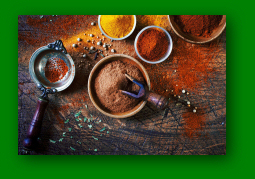 After the discovery of the Americas in 1492, Columbus made his first pilgrimage to the Royal Monastery of Santa Maria de Guadalupe, in Extremadura, Spain, to thank his discovery. It is assumed that by donating to the monks the pepper seeds, these were the first Europeans to discover the taste of spicy peppers and add them to their kitchen. Initially cultivated in monasteries, the seeds were then spread throughout Spain and Europe by monks travelers. Because of the expansion of the Venetian Republic, the boundaries of which came to Cyprus and the Ottoman Empire in the Balkans and the eastern Mediterranean, was May 20, 1498 that the Portuguese explorer Vasco da Gama allowed Portugal to be able to do without on business with the Arab traders, Persian, Turkish and Venetian, rounding the Cape of Good Hope and landing at Calicut in India where He established shortly after the first Portuguese trading colony in Goa. Subsequent trading colonies favored the spread of the Asian chilli until Timor. In 1542, some Portuguese missionaries brought the chili in Japan and then later reached Korea. From India, through Persia,the Turks introduced in 1570 the chili in Hungary.
After the discovery of the Americas in 1492, Columbus made his first pilgrimage to the Royal Monastery of Santa Maria de Guadalupe, in Extremadura, Spain, to thank his discovery. It is assumed that by donating to the monks the pepper seeds, these were the first Europeans to discover the taste of spicy peppers and add them to their kitchen. Initially cultivated in monasteries, the seeds were then spread throughout Spain and Europe by monks travelers. Because of the expansion of the Venetian Republic, the boundaries of which came to Cyprus and the Ottoman Empire in the Balkans and the eastern Mediterranean, was May 20, 1498 that the Portuguese explorer Vasco da Gama allowed Portugal to be able to do without on business with the Arab traders, Persian, Turkish and Venetian, rounding the Cape of Good Hope and landing at Calicut in India where He established shortly after the first Portuguese trading colony in Goa. Subsequent trading colonies favored the spread of the Asian chilli until Timor. In 1542, some Portuguese missionaries brought the chili in Japan and then later reached Korea. From India, through Persia,the Turks introduced in 1570 the chili in Hungary. 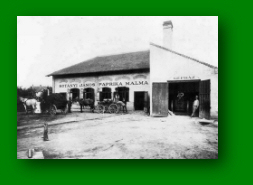 At first it was grown in the gardens aristocrats as rare but soon took his place among the most important ingredients in the kitchen. Through who knows how many and which crossing and selection, sweet pepper was introduced into Europe by the Hungarians who coined for the first time the name Paprika in 1724.
Today the chili is known and cultivated in most of the world and in many cultures has become part of the traditions.
At first it was grown in the gardens aristocrats as rare but soon took his place among the most important ingredients in the kitchen. Through who knows how many and which crossing and selection, sweet pepper was introduced into Europe by the Hungarians who coined for the first time the name Paprika in 1724.
Today the chili is known and cultivated in most of the world and in many cultures has become part of the traditions.
The chili pepper in the pre-Columbian era:
 The discovery of the Americas with the arrival of Christopher Columbus in 1492, revolutionized and changed all the themes and maxims of the world at the time, but also put an end to an era, an era called pre-Columbian. In this era in the Americas lived in different civilizations and cultures, and although many were already expired at the time of the arrival of Europeans, while others were still alive. Of the largest and most advanced we were, Aztecs, Toltecs, Maya, Chibcha, and Inca.
The discovery of the Americas with the arrival of Christopher Columbus in 1492, revolutionized and changed all the themes and maxims of the world at the time, but also put an end to an era, an era called pre-Columbian. In this era in the Americas lived in different civilizations and cultures, and although many were already expired at the time of the arrival of Europeans, while others were still alive. Of the largest and most advanced we were, Aztecs, Toltecs, Maya, Chibcha, and Inca. These civilizations built in previous centuries of this era is bloody human sacrifices to the gods, but also excelled on astronomy, craftsmanship, the building of temples and religious monuments sites and especially in agriculture. Thanks to the pre-Columbian civilizations was that Columbus could import animals in Europe and especially plant hitherto unknown. Cocoa, corn, potato, tomato, pumpkin, are just a few of the multitude of plants that the Americas were offered. Among them was also the chili, called ”Uchu” by the Incas, ”Pimiento de las Indias” by the Spanish, and later ”Aji” by the people of the West Indies, a name which has now become quite common in the Andes.
These civilizations built in previous centuries of this era is bloody human sacrifices to the gods, but also excelled on astronomy, craftsmanship, the building of temples and religious monuments sites and especially in agriculture. Thanks to the pre-Columbian civilizations was that Columbus could import animals in Europe and especially plant hitherto unknown. Cocoa, corn, potato, tomato, pumpkin, are just a few of the multitude of plants that the Americas were offered. Among them was also the chili, called ”Uchu” by the Incas, ”Pimiento de las Indias” by the Spanish, and later ”Aji” by the people of the West Indies, a name which has now become quite common in the Andes.  Many of the documents and reports of Colombo were lost while traveling and so today our culinary knowledge on the use of chili comes from pre-Columbian archaeological finds, from Spanish and Portuguese explorers of the sixteenth and seventeenth centuries and the missionary fathers. The evolution of chili but began thousands of years ago. Linda Perry, archeobiologa the Smithsonian National Museum of Natural History in Washington, DC led an international team that has used a relatively new technique called analysis of starch to find the remains of chili archaeological sites in the Americas.
Many of the documents and reports of Colombo were lost while traveling and so today our culinary knowledge on the use of chili comes from pre-Columbian archaeological finds, from Spanish and Portuguese explorers of the sixteenth and seventeenth centuries and the missionary fathers. The evolution of chili but began thousands of years ago. Linda Perry, archeobiologa the Smithsonian National Museum of Natural History in Washington, DC led an international team that has used a relatively new technique called analysis of starch to find the remains of chili archaeological sites in the Americas.  The researchers found that all species of chilli produce microscopic starch granules that look something like red blood cells. These granules were found on milling stones, pottery shards and sediments from seven archaeological sites 6000 years before contact with Europeans, ranging from Mexico, Panama, Bahamas, Venezuela, Ecuador and southern Peru. The oldest sites that host the granules are two prehistoric villages in the south-west of Ecuador in the sites of Loma Alta and Real Alto, occupied 6,100 years ago. This means that the peppers were routinely used as a condiment in the kitchen prehistoric times. The analysis of the remains and the study of starch granules, which store well and can be identified by species, revealed what is believed to be the beginning of a prehistoric vintage dated to about 8000 years ago, followed by cultivation and domestication final about 6,000 years ago.
The researchers found that all species of chilli produce microscopic starch granules that look something like red blood cells. These granules were found on milling stones, pottery shards and sediments from seven archaeological sites 6000 years before contact with Europeans, ranging from Mexico, Panama, Bahamas, Venezuela, Ecuador and southern Peru. The oldest sites that host the granules are two prehistoric villages in the south-west of Ecuador in the sites of Loma Alta and Real Alto, occupied 6,100 years ago. This means that the peppers were routinely used as a condiment in the kitchen prehistoric times. The analysis of the remains and the study of starch granules, which store well and can be identified by species, revealed what is believed to be the beginning of a prehistoric vintage dated to about 8000 years ago, followed by cultivation and domestication final about 6,000 years ago. 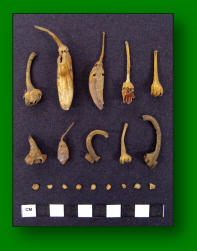 tamer version of the pepper fruit is larger than the wild versions and significant similarities in chillies analyzed, leading researchers to believe that there were at least two separate domestication events, one in South America, particularly in the south of the Brazil and Bolivia, and a second in Central America and Mexico. Mexico and Central America are thought to be the center of origin of Capsicum annuum and Capsicum frutescens while South America Capsicum chinense, Capsicum baccatum and Capsicum pubescens. The spread of domestic cultivation was determined by both the taste and culinary value that the research of calories. The associations of wheat starch show that corn and peppers have evolved together as an ancient and widespread Neotropical plant food before the ceramic in some regions. With the domestication and cultivation systematic, chili entered in the culture of pre-Columbian civilizations. Revered as a deity, the Incas considered him one of the four brothers of their creation myth: ”Ayar-Uchu” or ”Brother Pepper” and considered him to be the brother of the first Inca king. Garcilaso de la Vega said that the peppers were perceived to symbolize the teachings of the early brethren Inca. They were therefore considered as sacred plants and more rigorous fasts were those that prohibited the use of all the peppers. According to the historian L.E. Valcarcel, the peppers were so appreciated by the Inca society that were probably used as currency. Since there were no coins or banknotes, certain products such as chillies became part of a rudimentary monetary system. Valcarcel said that up to half of the twentieth century, people in the square of Cuzco could buy goods with Rantii, a handful of chillies. The pre-Columbian civilizations did not know the use of oil or grease in the kitchen, everything was cooked in sauce, boiled or roasted. Most of the dishes were made from chilli peppers and vegetarian. Fish and meat were luxuries for the common people. Also, thanks to the reports of the missionary fathers and findings, it was discovered that the Incas breakfast consisted of leftovers from the night before and a cup of Chicha, a slightly intoxicating drink made from fermented corn. The meals of the day often included boiled corn with peppers, potatoes and herbs to make a stew called Mote. Soups and stews of meat blade sun-dried, dehydrated potatoes, and peppers. Even the potatoes were ubiquitous. Another great civilization were the Maya who reached the peak of their civilization in southern Mexico and the Yucatan peninsula in 500 AD. They had a highly developed system of agriculture and corn was their most important crop, followed by beans, squash, peppers up to 30 different varieties, cocoa, cotton, papaya, vanilla beans, cassava and agave. The Maya also raised domestic turkeys, ducks and dogs. Their main game were deer, birds and wild boar. Armadillos and manatees were considered delicacies.
tamer version of the pepper fruit is larger than the wild versions and significant similarities in chillies analyzed, leading researchers to believe that there were at least two separate domestication events, one in South America, particularly in the south of the Brazil and Bolivia, and a second in Central America and Mexico. Mexico and Central America are thought to be the center of origin of Capsicum annuum and Capsicum frutescens while South America Capsicum chinense, Capsicum baccatum and Capsicum pubescens. The spread of domestic cultivation was determined by both the taste and culinary value that the research of calories. The associations of wheat starch show that corn and peppers have evolved together as an ancient and widespread Neotropical plant food before the ceramic in some regions. With the domestication and cultivation systematic, chili entered in the culture of pre-Columbian civilizations. Revered as a deity, the Incas considered him one of the four brothers of their creation myth: ”Ayar-Uchu” or ”Brother Pepper” and considered him to be the brother of the first Inca king. Garcilaso de la Vega said that the peppers were perceived to symbolize the teachings of the early brethren Inca. They were therefore considered as sacred plants and more rigorous fasts were those that prohibited the use of all the peppers. According to the historian L.E. Valcarcel, the peppers were so appreciated by the Inca society that were probably used as currency. Since there were no coins or banknotes, certain products such as chillies became part of a rudimentary monetary system. Valcarcel said that up to half of the twentieth century, people in the square of Cuzco could buy goods with Rantii, a handful of chillies. The pre-Columbian civilizations did not know the use of oil or grease in the kitchen, everything was cooked in sauce, boiled or roasted. Most of the dishes were made from chilli peppers and vegetarian. Fish and meat were luxuries for the common people. Also, thanks to the reports of the missionary fathers and findings, it was discovered that the Incas breakfast consisted of leftovers from the night before and a cup of Chicha, a slightly intoxicating drink made from fermented corn. The meals of the day often included boiled corn with peppers, potatoes and herbs to make a stew called Mote. Soups and stews of meat blade sun-dried, dehydrated potatoes, and peppers. Even the potatoes were ubiquitous. Another great civilization were the Maya who reached the peak of their civilization in southern Mexico and the Yucatan peninsula in 500 AD. They had a highly developed system of agriculture and corn was their most important crop, followed by beans, squash, peppers up to 30 different varieties, cocoa, cotton, papaya, vanilla beans, cassava and agave. The Maya also raised domestic turkeys, ducks and dogs. Their main game were deer, birds and wild boar. Armadillos and manatees were considered delicacies.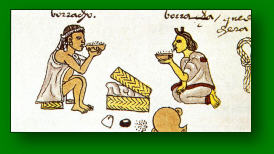 Their breakfast often included a paste of ground maize to the consistency of a milkshake flavored with chillies called Atole or pozol. The meals of the day included meat and vegetable stews, tortillas with bean paste, chillies and a little pumpkin. The meat was eaten only once a week and usually chicken or pork. The kitchen Aztec but it remained virtually unchanged for centuries becoming the basis of Mexican cuisine today. In fact, many Aztec dishes included stuffed peppers, tortillas with beans and a sauce made of peppers and tomatoes, tamales stuffed with fruits such as plums, pineapple and guava, with wild game such as deer or turkey, or seafood such as snails or frogs . All served with a sauce made by grinding the ingredients between two stones portable Suchilquitongo calls a time, but today Molcajetes stones.
Their breakfast often included a paste of ground maize to the consistency of a milkshake flavored with chillies called Atole or pozol. The meals of the day included meat and vegetable stews, tortillas with bean paste, chillies and a little pumpkin. The meat was eaten only once a week and usually chicken or pork. The kitchen Aztec but it remained virtually unchanged for centuries becoming the basis of Mexican cuisine today. In fact, many Aztec dishes included stuffed peppers, tortillas with beans and a sauce made of peppers and tomatoes, tamales stuffed with fruits such as plums, pineapple and guava, with wild game such as deer or turkey, or seafood such as snails or frogs . All served with a sauce made by grinding the ingredients between two stones portable Suchilquitongo calls a time, but today Molcajetes stones. 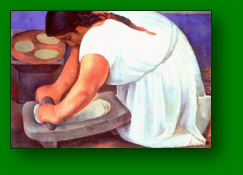 The Aztecs also loved drinking Chilote, a liqueur made of Pulque (fermented agave pulp), Ancho chiles and herbs. This liquor is the basis of today’s Tequila and Mezcal. During development through Central America and Mexico, chili earned the reputation of being also a powerful medicine. The pre - Columbian tribes of Panama used it in combination with cocoa and tobacco (and probably other plants) to enter into hallucinatory trance. According to the scientist Maria Helms, these Indians used it to ”travel” to heaven or to hell to negotiate with the good and evil spirits, on behalf of mankind. Today, the Cuna Indians of Panama burn chillies so that the irritating smoke to drive away evil spirits during the ceremony of puberty of a girl. It was the belief that establish a series of chillies behind their canoes to discourage attacks by sharks. For Tzotzil Indians of the Chiapas Highlands, chili assists both in life and in death. The peppers are rubbed on the lips of infants and are burned during funeral ceremonies in order to defeat the evil spirits that may be around. The tribe of San Carlos Huastec Potosi and Vera Cruz treat the victims of the ”evil eye” with an egg dipped in chili powder, then rubbed on the body of the victim to return the pain to the criminal. The Indians of the southern highlands Cicatec Mexicans use the Tepache, a glass of fermented sugar cane juice, with cocoa and chili, for use in various rituals. This mixture vividly remembers a similar combination consumed by the Aztecs who combined chocolate and chiles in a drink called Chicahuatl, which was usually reserved for priests and rich. After the arrival of Columbus, began a relentless destruction of the pre-Columbian civilizations by the Conquistadores, the evangelization and the creation of myths as the search for El dorado.
The Aztecs also loved drinking Chilote, a liqueur made of Pulque (fermented agave pulp), Ancho chiles and herbs. This liquor is the basis of today’s Tequila and Mezcal. During development through Central America and Mexico, chili earned the reputation of being also a powerful medicine. The pre - Columbian tribes of Panama used it in combination with cocoa and tobacco (and probably other plants) to enter into hallucinatory trance. According to the scientist Maria Helms, these Indians used it to ”travel” to heaven or to hell to negotiate with the good and evil spirits, on behalf of mankind. Today, the Cuna Indians of Panama burn chillies so that the irritating smoke to drive away evil spirits during the ceremony of puberty of a girl. It was the belief that establish a series of chillies behind their canoes to discourage attacks by sharks. For Tzotzil Indians of the Chiapas Highlands, chili assists both in life and in death. The peppers are rubbed on the lips of infants and are burned during funeral ceremonies in order to defeat the evil spirits that may be around. The tribe of San Carlos Huastec Potosi and Vera Cruz treat the victims of the ”evil eye” with an egg dipped in chili powder, then rubbed on the body of the victim to return the pain to the criminal. The Indians of the southern highlands Cicatec Mexicans use the Tepache, a glass of fermented sugar cane juice, with cocoa and chili, for use in various rituals. This mixture vividly remembers a similar combination consumed by the Aztecs who combined chocolate and chiles in a drink called Chicahuatl, which was usually reserved for priests and rich. After the arrival of Columbus, began a relentless destruction of the pre-Columbian civilizations by the Conquistadores, the evangelization and the creation of myths as the search for El dorado.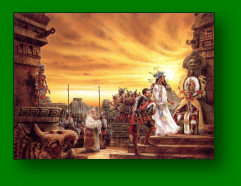 The conquistadors also brought the spread of new diseases and infections against which the natives did not have the immune system suitable, which caused a reduction in the population south and Mesoamerican now estimated in the order of 70% in less than a century . What the Spaniards with the conquest of the New World did not realize was that the New World would then conquered them. Today we enjoy on our tables every day products originally born thanks to the skill and expertise of the agricultural pre-Columbian civilizations.
The conquistadors also brought the spread of new diseases and infections against which the natives did not have the immune system suitable, which caused a reduction in the population south and Mesoamerican now estimated in the order of 70% in less than a century . What the Spaniards with the conquest of the New World did not realize was that the New World would then conquered them. Today we enjoy on our tables every day products originally born thanks to the skill and expertise of the agricultural pre-Columbian civilizations.
Sources and further investigation:
www.pnas.org/content/104/29/11905.full
news.sciencemag.org/sciencenow/2007/02/16-02.html
archaeology.about.com/od/cbthroughch/qt/Chili-Peppers.htm

